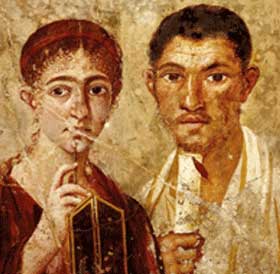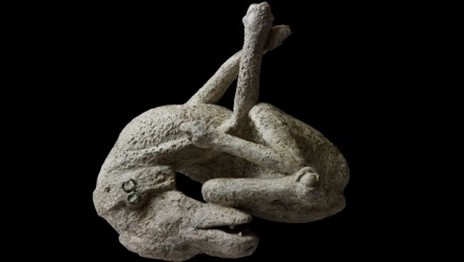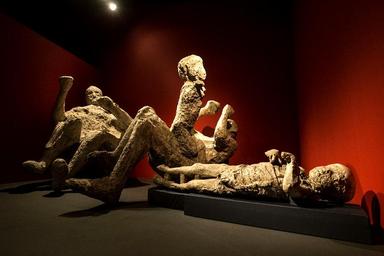 What a fantastic and moving exhibition is Life and Death in Pompei and Herculaneum at the British Museum. I’ve been to Pompei (but not to Herculaneum) and thought it would offer little new, but this proved to be an incredible insight into everyday life in the two cities. The exhibition is a total triumph and really brings the details of those worlds into vivid relief by taking you on a journey back to two days before Vesuvius erupts, firstly to a typical street with shops and bars and then room by room through a house and garden.
What a fantastic and moving exhibition is Life and Death in Pompei and Herculaneum at the British Museum. I’ve been to Pompei (but not to Herculaneum) and thought it would offer little new, but this proved to be an incredible insight into everyday life in the two cities. The exhibition is a total triumph and really brings the details of those worlds into vivid relief by taking you on a journey back to two days before Vesuvius erupts, firstly to a typical street with shops and bars and then room by room through a house and garden.
There is all human life here, from the bar room brawls (depicted on graffiti and frescoes), to the carbonised figs – plump and juicy that morning then turned into rock, from the erotic wallpaintings (I was astonished to discover that slaves carried on tidying up around the bedroom while the master and mistress of the house happily shagged away in front of them), to the wooden cradle – preserved but fortunately displayed without its tiny occupant who was found under a blanket, the kitchen utensils, the loaf of bread imprinted with the name of the salve who baked it, the lewd and rather shocking statue of a faun shagging a goat. (If you have small children be prepared to do some explaining or plan your route carefully!) and the highly sophisticated interior designs.

 What comes across so clearly is the sense of humour of these Romans, often irreverent, sometimes a bit bawdy. By the end of the circuit you really feel as though you have got to know the people who lived there and instead of being ancient Romans they seem living and breathing people, not dissimilar from their modern Neopolitan ancestors. It then comes as a dramatic and poignant awakening when you reach the final room and it is the day of the eruption. By now you really care about these people so it becomes a tragedy not just history. Even the pets tell their own sad story – with a poor dog writhing in mortal agony as it is overwhelmed with burning choking gases at extraordinary temperatures.
What comes across so clearly is the sense of humour of these Romans, often irreverent, sometimes a bit bawdy. By the end of the circuit you really feel as though you have got to know the people who lived there and instead of being ancient Romans they seem living and breathing people, not dissimilar from their modern Neopolitan ancestors. It then comes as a dramatic and poignant awakening when you reach the final room and it is the day of the eruption. By now you really care about these people so it becomes a tragedy not just history. Even the pets tell their own sad story – with a poor dog writhing in mortal agony as it is overwhelmed with burning choking gases at extraordinary temperatures.
 The final tableau is a the bodies of a small family, father and young son in the characteristic “boxer position” caused by the tendons contracting under the extreme of the heat, mother trying to hold onto her small child who is in turn stretching away from her, trying to climb up the wall and escape. All frozen for ever in a terrible and agonising death. These people were buried under metres of ash and when they eventually disntegrated they left body shaped voids which were filled with plaster of paris to make these terribly sad figures, complete with facial features and the shape of clothing.
The final tableau is a the bodies of a small family, father and young son in the characteristic “boxer position” caused by the tendons contracting under the extreme of the heat, mother trying to hold onto her small child who is in turn stretching away from her, trying to climb up the wall and escape. All frozen for ever in a terrible and agonising death. These people were buried under metres of ash and when they eventually disntegrated they left body shaped voids which were filled with plaster of paris to make these terribly sad figures, complete with facial features and the shape of clothing.
If you only see one exhibition this year make it this one. I skived off yesterday for my visit – but it was worth it as I have had an incredibly productive writing day today.


0 Comments